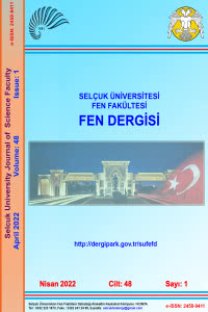EFFECT OF HEIGHT ON THE STATIC STABILITY OF HETEROGENEOUS EMBANKMENT DAMS
Hetorojen Embankment Barajların Statik Stabilisezi Üzerinde Yüksekliğin Etkisi
___
- Banaki, R., Ahmad, F., Tabarroki M., Yahaya A.S., 2013, “Probabilistic Analyses of Slopes: A State of the Art”, International Journal of Current Engineering and Technology, Vol. 3(1), pp. 58 -63.
- Cui, Y. J., Gao, Y. B., Ferber, V., 2010, “Simulating the Water Content and Temper ature Changes in an Experimental Embankment Using Meteorological Data”, Engineering Geology, Vol. 114(3), pp. 456-471.
- Gikas, V., Sakellariou M., 2008. “Settlement Analysis of The Mornos Earth Dam (Greece): Evidence from Numerical Modeling and Geodetic Monitoring”, Engineering Structures, Vol. 30(11), pp. 3074 – 3081.
- Ismail, M.A.M, Ng, S. M, Gey, E.K., 2012, “Stability Analysis of Kelau Earth-Fill Dam Design under Main Critical Conditions”, The Electronic Journal of Geotechnical Engineering, Vol. 17
- Maharjan, M., Takahashi, A., 2014, “Liquefaction-Induced Deformation of Earthen Embankments on Non-Homogeneous Soil Deposits Under Sequential Ground Motions”, Soil Dynamics and Earthquake Engineering, Vol. 66, pp. 113-124.
- Manafi Ghorabaei S.M, Noorzad, A., Mahdavifar, M., Soleimannejad, A., 2012, “Risk Analysis of the Slope Stability of Embankment Dam Using Three Different Approaches”, 6th International Symposium on Advances In Science and Technology, Kuala Lumpur, Malay sia, 24-25 March, 2012.
- Manafi Ghorabaei, S M, Noorzad, A, 2011. “Role of Risk Assessment in Repair and Rehabilitation of Earth Dams”, Proceedings of the National Workshop on Operation, Maintenance and Rehabilitation of Dams and Hydropower Plants, Tehran, Iran: Iranian National Committee on Large Dams (IRCOLD).
- Morgenstern, N.R., Price, V.E., 1965, “The Analysis of the Stability of General Slip Surface” Geotechnique, Vol. 15, pp. 79-93.
- Novak, P., Moffat, A.I.B., Nalluri, C., Narayanan, R., 2001, Hydraulic Structures Fourth Edition, Taylor & Francis Group, London.
- Ratnayaka, D.D., Brandt, M.J., Johnson, M., 2009, Twort's Water Supply 6th Edition, Butterworth - Heinemann: Elsevier.
- Sakamoto, T., Yoshida, H., Yamaguchi, Y., Satoh, H., Tomoya, I., 2002, “Numeri cal Simulation of Sliding of An Earth Dam During The 1995 Kobe Earthquake” in Proceedings of the 22nd USSD Annual Meeting and Conference, Pre-conference Workshop, 3rd U.S.Japan Workshop on Advanced Research on Earthquake Engineering for Dams, San Diego, Ca lifornia, 26-31 March 2001.
- Seepage Modeling with SEEP/W, 2007, An Engineering Methodology Third Edition, March 2008 , GEOSLOPE International Ltd., Canada.
- Spencer E, 1967, “A Method of Analysis of The Stability of Embankments assuming Parallel Interslice Forces”, Geotechnique, Vol 17 (1), pp. 11-26.
- Stability Modeling with SLOPE/W, 2007, An Engineering Methodology Third Edition, March 2008 , GEOSLOPE International Ltd
- Tran, T.X., 2004, Stability problems of An Earth Fill Dam in Rapid Drawdown Condition, Doctoral dissertation Slovak University of Technology, Bratislava, Slovak Republic.
- United States Society on Dams, 2007, Strength of Materials for Embankment Dams, Denver, USA: US Society on Dams.
- US Army Corps of Engineers, 2003, Engineering and Design - Slope Stability, Washington DC, USA: US Army Corps of Engineers.
- USBR, 2011, Design standard No. 13, Embankment Dams, Chapter 4: Static Stability Analysis, U.S, Department of the Interior, Bureau of Reclamation.
- ISSN: 2147-9364
- Yayın Aralığı: 2
- Başlangıç: 2013
- Yayıncı: Selçuk Üniversitesi Mühendislik Fakültesi
BER OF ANNULAR BEAMS IN WEAK OCEANIC TURBULENCE
EFFECT OF HEIGHT ON THE STATIC STABILITY OF HETEROGENEOUS EMBANKMENT DAMS
Mohsen YAZDANIAN, Hamid Reza AFSHOON, Sadegh GHASEMI, Vahid AFSHOON, Farhad FAHIM
HALİL AKINCI, SEDAT DOĞAN, CEM KILIÇOĞLU
GEOLOGICAL AND GEOMECHANICAL PROPERTIES OF SOME CARBONATE MARBLES AND BASALT STONE FROM MOROCCO
VEYSEL ZEDEF, KERİM KOÇAK, Najib Mohamed ZAGHLOUL, ADNAN DÖYEN, ALİ RIZA SÖĞÜT, HAKAN ÖZŞEN, BİLGEHAN KEKEÇ, ALİ ARAS, KEMAL DOĞAN, TEVFİK AĞAÇAYAK
YERALTI LİNYİT KÖMÜR MADENİNDE TERMAL KONFOR ŞARTLARININ İNCELENMESİ
SULPHURIC ACID LEACHING UNDER EFFECT OF SODIUM FLUORIDE
THE DYNAMIC FACILITY LAYOUT PROBLEMS WITH CLOSENESS RATE: A FUZZY DECISION SUPPORT SYSTEM APPROACH
